Marketing Strategy
VerifiedAdded on 2022/12/15
|18
|4188
|334
AI Summary
This report evaluates the marketing strategy of Ariel detergent, including situational analysis, competitive advantage, evaluation of current marketing strategy, and segmentation, targeting, and positioning.
Contribute Materials
Your contribution can guide someone’s learning journey. Share your
documents today.

Marketing Strategy
6 / 2 6 / 2 0 1 9
6 / 2 6 / 2 0 1 9
Secure Best Marks with AI Grader
Need help grading? Try our AI Grader for instant feedback on your assignments.
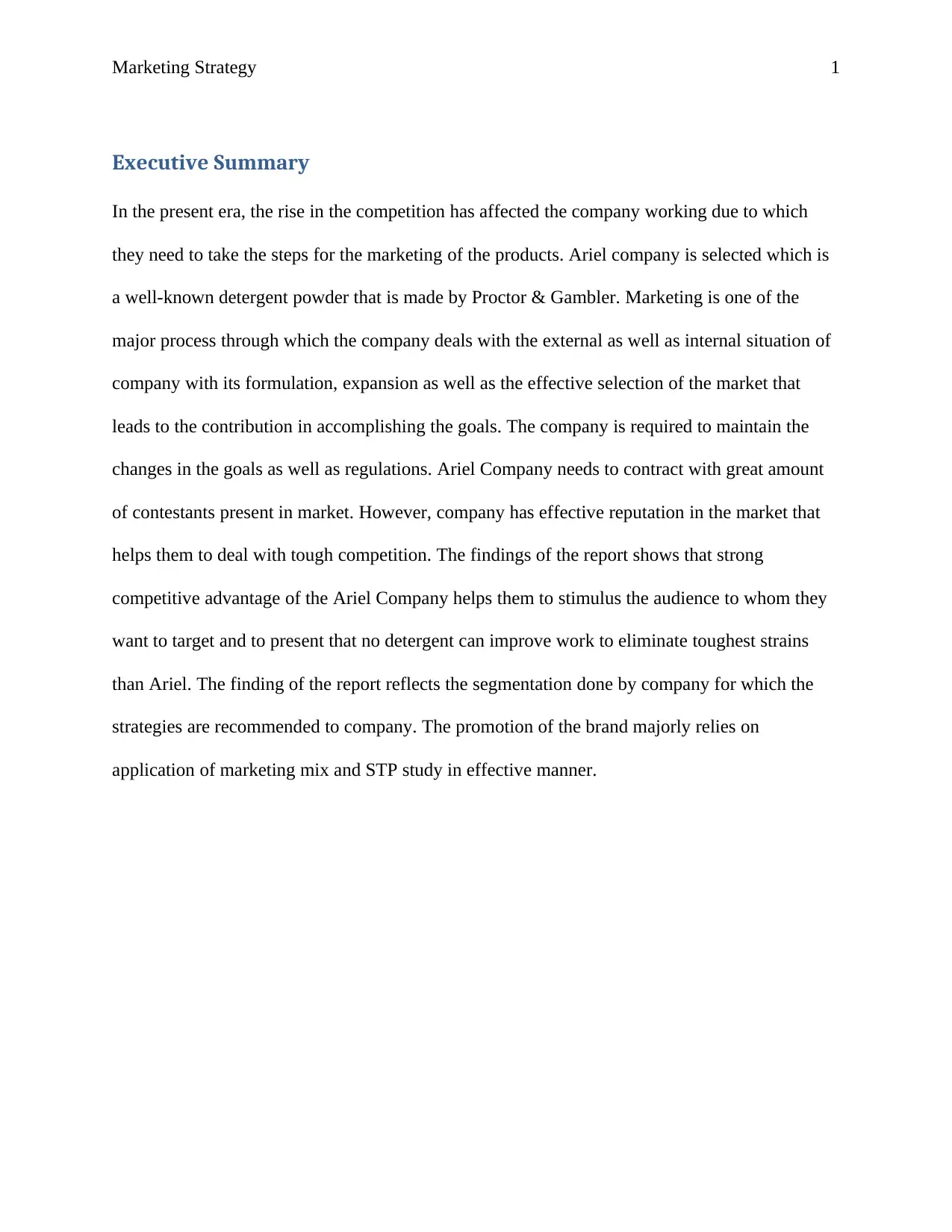
Marketing Strategy 1
Executive Summary
In the present era, the rise in the competition has affected the company working due to which
they need to take the steps for the marketing of the products. Ariel company is selected which is
a well-known detergent powder that is made by Proctor & Gambler. Marketing is one of the
major process through which the company deals with the external as well as internal situation of
company with its formulation, expansion as well as the effective selection of the market that
leads to the contribution in accomplishing the goals. The company is required to maintain the
changes in the goals as well as regulations. Ariel Company needs to contract with great amount
of contestants present in market. However, company has effective reputation in the market that
helps them to deal with tough competition. The findings of the report shows that strong
competitive advantage of the Ariel Company helps them to stimulus the audience to whom they
want to target and to present that no detergent can improve work to eliminate toughest strains
than Ariel. The finding of the report reflects the segmentation done by company for which the
strategies are recommended to company. The promotion of the brand majorly relies on
application of marketing mix and STP study in effective manner.
Executive Summary
In the present era, the rise in the competition has affected the company working due to which
they need to take the steps for the marketing of the products. Ariel company is selected which is
a well-known detergent powder that is made by Proctor & Gambler. Marketing is one of the
major process through which the company deals with the external as well as internal situation of
company with its formulation, expansion as well as the effective selection of the market that
leads to the contribution in accomplishing the goals. The company is required to maintain the
changes in the goals as well as regulations. Ariel Company needs to contract with great amount
of contestants present in market. However, company has effective reputation in the market that
helps them to deal with tough competition. The findings of the report shows that strong
competitive advantage of the Ariel Company helps them to stimulus the audience to whom they
want to target and to present that no detergent can improve work to eliminate toughest strains
than Ariel. The finding of the report reflects the segmentation done by company for which the
strategies are recommended to company. The promotion of the brand majorly relies on
application of marketing mix and STP study in effective manner.
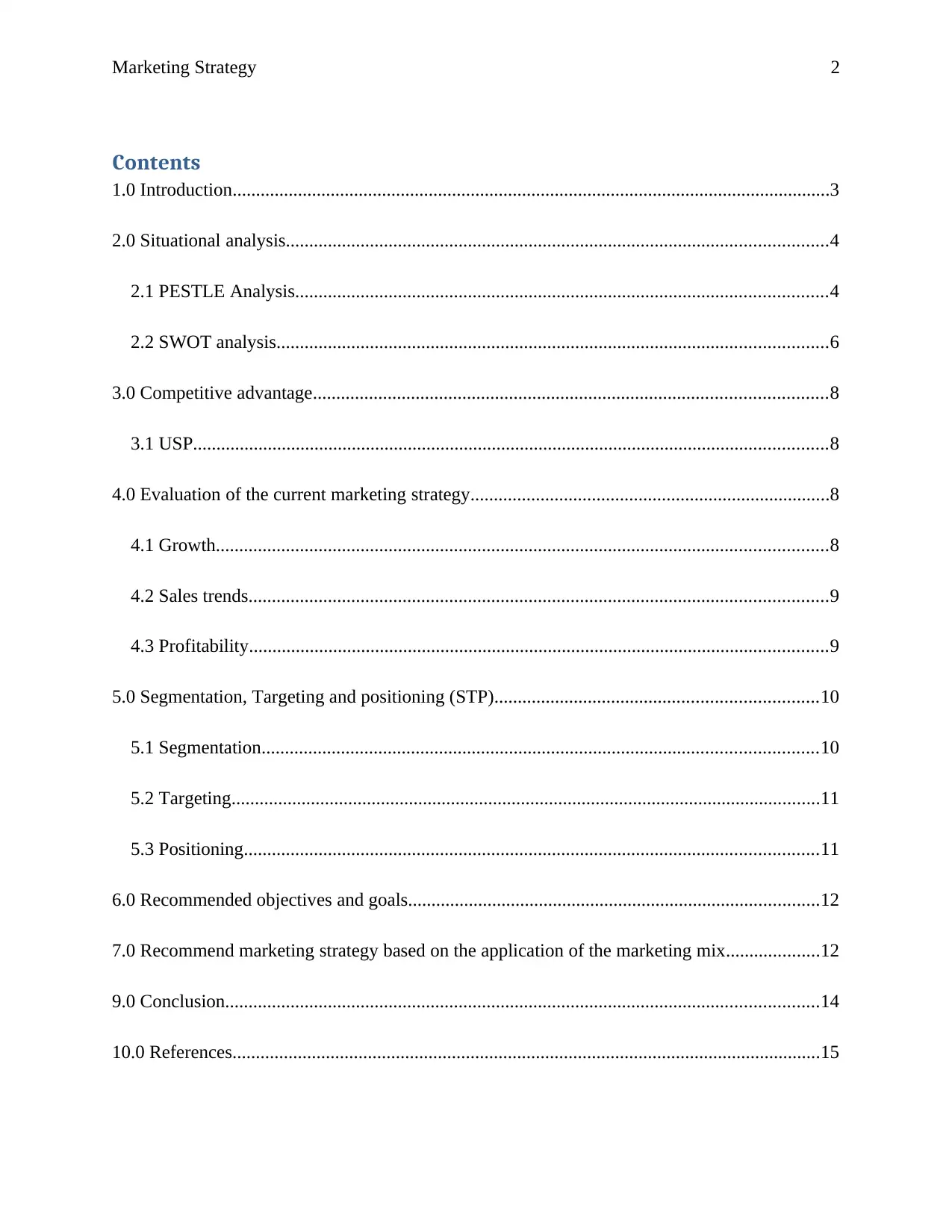
Marketing Strategy 2
Contents
1.0 Introduction................................................................................................................................3
2.0 Situational analysis....................................................................................................................4
2.1 PESTLE Analysis..................................................................................................................4
2.2 SWOT analysis......................................................................................................................6
3.0 Competitive advantage..............................................................................................................8
3.1 USP........................................................................................................................................8
4.0 Evaluation of the current marketing strategy.............................................................................8
4.1 Growth...................................................................................................................................8
4.2 Sales trends............................................................................................................................9
4.3 Profitability............................................................................................................................9
5.0 Segmentation, Targeting and positioning (STP).....................................................................10
5.1 Segmentation.......................................................................................................................10
5.2 Targeting..............................................................................................................................11
5.3 Positioning...........................................................................................................................11
6.0 Recommended objectives and goals........................................................................................12
7.0 Recommend marketing strategy based on the application of the marketing mix....................12
9.0 Conclusion...............................................................................................................................14
10.0 References..............................................................................................................................15
Contents
1.0 Introduction................................................................................................................................3
2.0 Situational analysis....................................................................................................................4
2.1 PESTLE Analysis..................................................................................................................4
2.2 SWOT analysis......................................................................................................................6
3.0 Competitive advantage..............................................................................................................8
3.1 USP........................................................................................................................................8
4.0 Evaluation of the current marketing strategy.............................................................................8
4.1 Growth...................................................................................................................................8
4.2 Sales trends............................................................................................................................9
4.3 Profitability............................................................................................................................9
5.0 Segmentation, Targeting and positioning (STP).....................................................................10
5.1 Segmentation.......................................................................................................................10
5.2 Targeting..............................................................................................................................11
5.3 Positioning...........................................................................................................................11
6.0 Recommended objectives and goals........................................................................................12
7.0 Recommend marketing strategy based on the application of the marketing mix....................12
9.0 Conclusion...............................................................................................................................14
10.0 References..............................................................................................................................15

Marketing Strategy 3
1.0 Introduction
The purpose of report is to determine organisation either producer or brand owner to get
involved in the marketing of detergents either single product or product line. Further, the report
is prepared with the motive to evaluate marketing elements of company. The business that has
been particular for examination is Ariel detergent that is a promotion line of washing detergents
made by Procter & Gambler. The brand Ariel first looked in 1967, UK market and since then it is
considered as first cleaner with stain-removing enzymes solution for the customers (Ariel, 2019).
The report includes marketing audit that include external as well as the internal environments.
Further, it includes the SWOT analysis that helps in assessing the company to take the
opportunity and contribute in converting the weakness into the strength. Moreover, the
evaluation of the competitive performance has been which shows the USP of company, growth,
sales, profitability and many others (Ariel, 2019). Considering this analysis on Ariel, detergents
the target segment as well as clearly marketing objectives are presented. Further, the marketing
mix connected to company shows strategy that the company should follow to attain the benefit in
the market.
1.0 Introduction
The purpose of report is to determine organisation either producer or brand owner to get
involved in the marketing of detergents either single product or product line. Further, the report
is prepared with the motive to evaluate marketing elements of company. The business that has
been particular for examination is Ariel detergent that is a promotion line of washing detergents
made by Procter & Gambler. The brand Ariel first looked in 1967, UK market and since then it is
considered as first cleaner with stain-removing enzymes solution for the customers (Ariel, 2019).
The report includes marketing audit that include external as well as the internal environments.
Further, it includes the SWOT analysis that helps in assessing the company to take the
opportunity and contribute in converting the weakness into the strength. Moreover, the
evaluation of the competitive performance has been which shows the USP of company, growth,
sales, profitability and many others (Ariel, 2019). Considering this analysis on Ariel, detergents
the target segment as well as clearly marketing objectives are presented. Further, the marketing
mix connected to company shows strategy that the company should follow to attain the benefit in
the market.
Secure Best Marks with AI Grader
Need help grading? Try our AI Grader for instant feedback on your assignments.

Marketing Strategy 4
2.0 Situational analysis
Situational study is considered as gathering of the method that is used by directors with the cause
to evaluate the interior as well as the outside environment that helps manager to understand
capabilities, clients as well as the business environment (Armstrong, Adam, Denize and Kotler,
2014).
2.1 PESTLE Analysis
PESTLE Analysis is a framework that is majorly used by the manager of the company in order to
evaluate and monitor macro-environmental influences that can create impact on the performance
of the organisation.
Political factors: - Political factors leads to huge effect on the working of company as
P&G company is required to maintain the regional, local as well as the global rules as
well as regulation (Baker, 2014). The publicity of the company gets affected if it
remained unfulfilled. Ariel detergent is affected due to change in taxation system in UK
because this will affect the profit of company. This has been witnessed that after all the
change in the rules and regulations but the company is able to manage the relations with
the government.
Economic factors: - The economic factors that majorly influence the working include
GDP, purchasing power and many others. The position of economy of UK is
comparatively better while comparing it with other countries. In the year 2017, the GDP
of country was 2622.43 billion US dollars that is quite less than the previous years as
well as required to be improved. The decline in the GDP affects the purchasing power of
consumer that creates the impact on demand of Ariel in the market. In UK Procter &
2.0 Situational analysis
Situational study is considered as gathering of the method that is used by directors with the cause
to evaluate the interior as well as the outside environment that helps manager to understand
capabilities, clients as well as the business environment (Armstrong, Adam, Denize and Kotler,
2014).
2.1 PESTLE Analysis
PESTLE Analysis is a framework that is majorly used by the manager of the company in order to
evaluate and monitor macro-environmental influences that can create impact on the performance
of the organisation.
Political factors: - Political factors leads to huge effect on the working of company as
P&G company is required to maintain the regional, local as well as the global rules as
well as regulation (Baker, 2014). The publicity of the company gets affected if it
remained unfulfilled. Ariel detergent is affected due to change in taxation system in UK
because this will affect the profit of company. This has been witnessed that after all the
change in the rules and regulations but the company is able to manage the relations with
the government.
Economic factors: - The economic factors that majorly influence the working include
GDP, purchasing power and many others. The position of economy of UK is
comparatively better while comparing it with other countries. In the year 2017, the GDP
of country was 2622.43 billion US dollars that is quite less than the previous years as
well as required to be improved. The decline in the GDP affects the purchasing power of
consumer that creates the impact on demand of Ariel in the market. In UK Procter &

Marketing Strategy 5
Gamble, increase 19% market share from Ariel detergent and its succeeding product lines
(Trading Economics, 2019).
Social factors: - Social factors contain modification in needs and demand of customers
that influence the demand of detergents. Ariel has established a good reputation over
different ages for serving bets detergent of market. The brand of Ariel is concerned for its
customer health as well as safety due to which they promote less consumption of the
renewable resources (Chernev, 2018). The logo of Ariel shows the positive sign that
promote the social desirability and this is the reason due to which customers likes to
purchase the product offer by brand in UK market.
Technological factors: - Technology is major factors behind the working of company as
the up-gradation in technology can affect the operations in the favour or against. Ariel
brand remains highly dependent on the technology due to which they work with the
motive to improve the brand quality as well as its image (David, 2011). IT experts of the
company ensure that they are able to make use of effective technology through which the
company can meet up the needs of the customers. This has been found that they had the
risk of absence of practical ability that will soon pull of the detergent from the market
where they have the high competition that remain present in the global market. P&G
Company majorly use technology so that they can reduce the cost related to the
production of detergent with the help of the effective IT capabilities in the global level.
Legal factors: - Ariel brand of P&G needs to ensure that they are able to follow entire
rules and regulation of dissimilar. This is the fact that diverse companies across the world
have wide range of differences in the rules and regulations. P&G ensures that they are
able to maintain good relations with the government that helps to remain aware about the
Gamble, increase 19% market share from Ariel detergent and its succeeding product lines
(Trading Economics, 2019).
Social factors: - Social factors contain modification in needs and demand of customers
that influence the demand of detergents. Ariel has established a good reputation over
different ages for serving bets detergent of market. The brand of Ariel is concerned for its
customer health as well as safety due to which they promote less consumption of the
renewable resources (Chernev, 2018). The logo of Ariel shows the positive sign that
promote the social desirability and this is the reason due to which customers likes to
purchase the product offer by brand in UK market.
Technological factors: - Technology is major factors behind the working of company as
the up-gradation in technology can affect the operations in the favour or against. Ariel
brand remains highly dependent on the technology due to which they work with the
motive to improve the brand quality as well as its image (David, 2011). IT experts of the
company ensure that they are able to make use of effective technology through which the
company can meet up the needs of the customers. This has been found that they had the
risk of absence of practical ability that will soon pull of the detergent from the market
where they have the high competition that remain present in the global market. P&G
Company majorly use technology so that they can reduce the cost related to the
production of detergent with the help of the effective IT capabilities in the global level.
Legal factors: - Ariel brand of P&G needs to ensure that they are able to follow entire
rules and regulation of dissimilar. This is the fact that diverse companies across the world
have wide range of differences in the rules and regulations. P&G ensures that they are
able to maintain good relations with the government that helps to remain aware about the
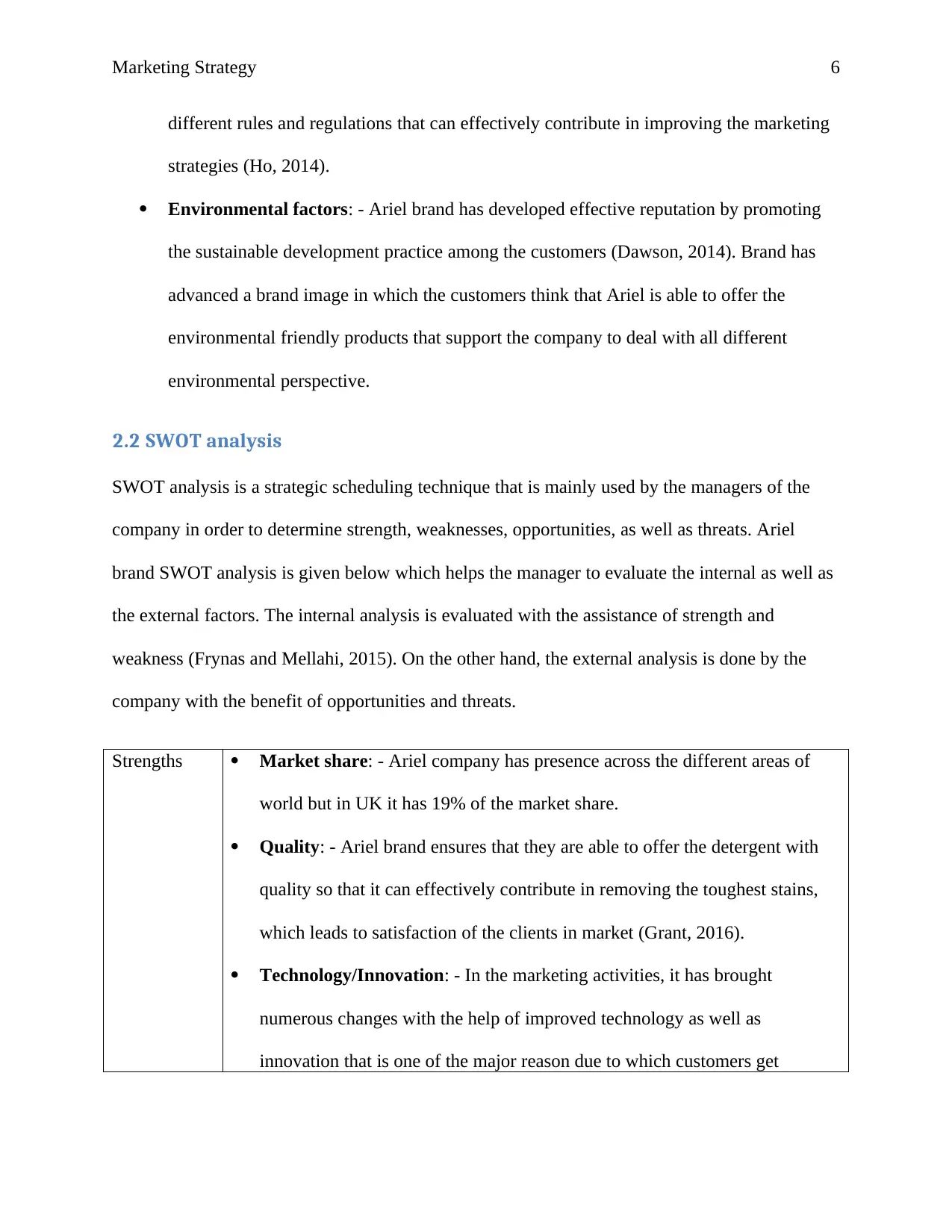
Marketing Strategy 6
different rules and regulations that can effectively contribute in improving the marketing
strategies (Ho, 2014).
Environmental factors: - Ariel brand has developed effective reputation by promoting
the sustainable development practice among the customers (Dawson, 2014). Brand has
advanced a brand image in which the customers think that Ariel is able to offer the
environmental friendly products that support the company to deal with all different
environmental perspective.
2.2 SWOT analysis
SWOT analysis is a strategic scheduling technique that is mainly used by the managers of the
company in order to determine strength, weaknesses, opportunities, as well as threats. Ariel
brand SWOT analysis is given below which helps the manager to evaluate the internal as well as
the external factors. The internal analysis is evaluated with the assistance of strength and
weakness (Frynas and Mellahi, 2015). On the other hand, the external analysis is done by the
company with the benefit of opportunities and threats.
Strengths Market share: - Ariel company has presence across the different areas of
world but in UK it has 19% of the market share.
Quality: - Ariel brand ensures that they are able to offer the detergent with
quality so that it can effectively contribute in removing the toughest stains,
which leads to satisfaction of the clients in market (Grant, 2016).
Technology/Innovation: - In the marketing activities, it has brought
numerous changes with the help of improved technology as well as
innovation that is one of the major reason due to which customers get
different rules and regulations that can effectively contribute in improving the marketing
strategies (Ho, 2014).
Environmental factors: - Ariel brand has developed effective reputation by promoting
the sustainable development practice among the customers (Dawson, 2014). Brand has
advanced a brand image in which the customers think that Ariel is able to offer the
environmental friendly products that support the company to deal with all different
environmental perspective.
2.2 SWOT analysis
SWOT analysis is a strategic scheduling technique that is mainly used by the managers of the
company in order to determine strength, weaknesses, opportunities, as well as threats. Ariel
brand SWOT analysis is given below which helps the manager to evaluate the internal as well as
the external factors. The internal analysis is evaluated with the assistance of strength and
weakness (Frynas and Mellahi, 2015). On the other hand, the external analysis is done by the
company with the benefit of opportunities and threats.
Strengths Market share: - Ariel company has presence across the different areas of
world but in UK it has 19% of the market share.
Quality: - Ariel brand ensures that they are able to offer the detergent with
quality so that it can effectively contribute in removing the toughest stains,
which leads to satisfaction of the clients in market (Grant, 2016).
Technology/Innovation: - In the marketing activities, it has brought
numerous changes with the help of improved technology as well as
innovation that is one of the major reason due to which customers get
Paraphrase This Document
Need a fresh take? Get an instant paraphrase of this document with our AI Paraphraser

Marketing Strategy 7
attracted and make the purchase of Ariel as their detergent.
Weaknesses Substitutes: - Customers in the market can simply discover the substitute of
detergent due to which they can switch to other brand that indicate to the
direct impact on the transactions of company. For instance, Unilever
Company is able to maintain 18% market share in UK that shows it is one of
the major substitute that is available.
Opportunitie
s
Un-trapped markets: - It has been witnessed that P&G company has its
operations in the urban areas where the rural areas remain un-trapped. One of
the biggest opportunities for Ariel company is to cover the un-trapped rural
area that can offer the improvement in the profits (Bhasin, 2016).
Effective brand traces: - Ariel brand has effective brand traces through
which it can usage its brand image traces in mind and heart of clients to
enhance its customer base within the market.
Threats Competition: - The rise in the competition is considered as one of the
emerging threat for Ariel company because of the presence of different brand
like Persil, Henkel and many others.
Pricing market: - Pricing market is considered as one of the major threat for
the company in the market. The existence of aggressive competition might
affect the company because they also bring the changes in price of products.
attracted and make the purchase of Ariel as their detergent.
Weaknesses Substitutes: - Customers in the market can simply discover the substitute of
detergent due to which they can switch to other brand that indicate to the
direct impact on the transactions of company. For instance, Unilever
Company is able to maintain 18% market share in UK that shows it is one of
the major substitute that is available.
Opportunitie
s
Un-trapped markets: - It has been witnessed that P&G company has its
operations in the urban areas where the rural areas remain un-trapped. One of
the biggest opportunities for Ariel company is to cover the un-trapped rural
area that can offer the improvement in the profits (Bhasin, 2016).
Effective brand traces: - Ariel brand has effective brand traces through
which it can usage its brand image traces in mind and heart of clients to
enhance its customer base within the market.
Threats Competition: - The rise in the competition is considered as one of the
emerging threat for Ariel company because of the presence of different brand
like Persil, Henkel and many others.
Pricing market: - Pricing market is considered as one of the major threat for
the company in the market. The existence of aggressive competition might
affect the company because they also bring the changes in price of products.
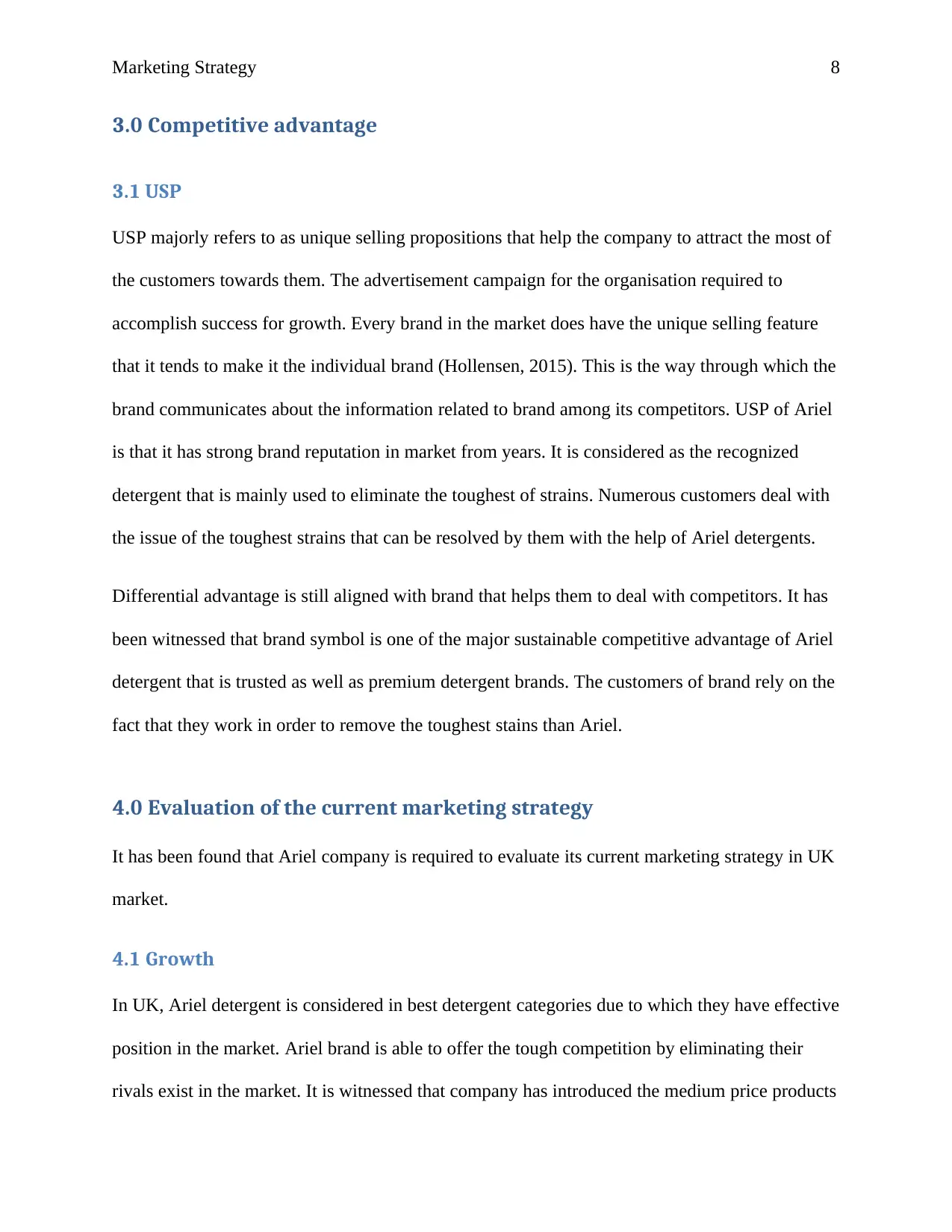
Marketing Strategy 8
3.0 Competitive advantage
3.1 USP
USP majorly refers to as unique selling propositions that help the company to attract the most of
the customers towards them. The advertisement campaign for the organisation required to
accomplish success for growth. Every brand in the market does have the unique selling feature
that it tends to make it the individual brand (Hollensen, 2015). This is the way through which the
brand communicates about the information related to brand among its competitors. USP of Ariel
is that it has strong brand reputation in market from years. It is considered as the recognized
detergent that is mainly used to eliminate the toughest of strains. Numerous customers deal with
the issue of the toughest strains that can be resolved by them with the help of Ariel detergents.
Differential advantage is still aligned with brand that helps them to deal with competitors. It has
been witnessed that brand symbol is one of the major sustainable competitive advantage of Ariel
detergent that is trusted as well as premium detergent brands. The customers of brand rely on the
fact that they work in order to remove the toughest stains than Ariel.
4.0 Evaluation of the current marketing strategy
It has been found that Ariel company is required to evaluate its current marketing strategy in UK
market.
4.1 Growth
In UK, Ariel detergent is considered in best detergent categories due to which they have effective
position in the market. Ariel brand is able to offer the tough competition by eliminating their
rivals exist in the market. It is witnessed that company has introduced the medium price products
3.0 Competitive advantage
3.1 USP
USP majorly refers to as unique selling propositions that help the company to attract the most of
the customers towards them. The advertisement campaign for the organisation required to
accomplish success for growth. Every brand in the market does have the unique selling feature
that it tends to make it the individual brand (Hollensen, 2015). This is the way through which the
brand communicates about the information related to brand among its competitors. USP of Ariel
is that it has strong brand reputation in market from years. It is considered as the recognized
detergent that is mainly used to eliminate the toughest of strains. Numerous customers deal with
the issue of the toughest strains that can be resolved by them with the help of Ariel detergents.
Differential advantage is still aligned with brand that helps them to deal with competitors. It has
been witnessed that brand symbol is one of the major sustainable competitive advantage of Ariel
detergent that is trusted as well as premium detergent brands. The customers of brand rely on the
fact that they work in order to remove the toughest stains than Ariel.
4.0 Evaluation of the current marketing strategy
It has been found that Ariel company is required to evaluate its current marketing strategy in UK
market.
4.1 Growth
In UK, Ariel detergent is considered in best detergent categories due to which they have effective
position in the market. Ariel brand is able to offer the tough competition by eliminating their
rivals exist in the market. It is witnessed that company has introduced the medium price products

Marketing Strategy 9
so that they can beat their rivals who offers the products at the lesser prices (Wilson and Gilligan,
2012). It has been found that purchasing power of the customers influences them to shift towards
the product available at low prices. The motive to offer detergent at medium priced so that they
can acquire the market for the detergent that are available within the market for medium price
market. The growth remained the continuous with the support of promotional activities as well as
advertisements.
4.2 Sales trends
The sales trends are essential to be maintained by the company that might get affected due to
rigid rivalry in marketplace. In the market, it has been found that Detergents Company have
equal share in terms of the market share (Rothaermel, 2015). The top competitors of the
company offer the product at lower costs that leads to the threat for company.
4.3 Profitability
In the present market, the profitability of the company gets affected due to the wide range of
competitors present in UK market. Ariel is able to accomplish revenue in market because they
so that they can beat their rivals who offers the products at the lesser prices (Wilson and Gilligan,
2012). It has been found that purchasing power of the customers influences them to shift towards
the product available at low prices. The motive to offer detergent at medium priced so that they
can acquire the market for the detergent that are available within the market for medium price
market. The growth remained the continuous with the support of promotional activities as well as
advertisements.
4.2 Sales trends
The sales trends are essential to be maintained by the company that might get affected due to
rigid rivalry in marketplace. In the market, it has been found that Detergents Company have
equal share in terms of the market share (Rothaermel, 2015). The top competitors of the
company offer the product at lower costs that leads to the threat for company.
4.3 Profitability
In the present market, the profitability of the company gets affected due to the wide range of
competitors present in UK market. Ariel is able to accomplish revenue in market because they
Secure Best Marks with AI Grader
Need help grading? Try our AI Grader for instant feedback on your assignments.

Marketing Strategy 10
offer the best quality product. The customers link the price of detergent with quality that leads to
improvement in revenue from the sales (Kotler, 2015).
5.0 Segmentation, Targeting and positioning (STP)
5.1 Segmentation
Customer segmentation is refers to market that include group of customers who are majorly
considered by the company for targeting the people for their products. Ariel Company also
considering the customer segmentation in which they determine the potential consumers that
play a vital role for company (Kumar, Rahman, Kazmi and Goyal, 2012). The marketplace is
exiting segmentation for clients that remains easy for them. Ariel is one of the single brands that
are majorly obligatory by entire sections of society but the size of packet they buy might also
vary. The market segmentation for Ariel Company has been given below –
Demographic segmentation: - In this segmentation, the customers are selected on certain
characteristics which include age, income, gender and many others. Ariel Company majorly uses
this type of segmentation that includes the young as well as middle-aged women who rinse
clothes of their family (Lovelock and Patterson, 2015). The women is majorly segment because
they consume this product being it married as well as unmarried, housewife as well as working
women and many others. Thus, they do not consider the occupation as well as the educational
background.
Geographic segmentation: - In the geographic segmentation, consumer are targeted based on
their location as well as regions. In the research, this is witnessed that major use of the detergent
is done by the consumer available at the urban area because rural people are easily accessible
offer the best quality product. The customers link the price of detergent with quality that leads to
improvement in revenue from the sales (Kotler, 2015).
5.0 Segmentation, Targeting and positioning (STP)
5.1 Segmentation
Customer segmentation is refers to market that include group of customers who are majorly
considered by the company for targeting the people for their products. Ariel Company also
considering the customer segmentation in which they determine the potential consumers that
play a vital role for company (Kumar, Rahman, Kazmi and Goyal, 2012). The marketplace is
exiting segmentation for clients that remains easy for them. Ariel is one of the single brands that
are majorly obligatory by entire sections of society but the size of packet they buy might also
vary. The market segmentation for Ariel Company has been given below –
Demographic segmentation: - In this segmentation, the customers are selected on certain
characteristics which include age, income, gender and many others. Ariel Company majorly uses
this type of segmentation that includes the young as well as middle-aged women who rinse
clothes of their family (Lovelock and Patterson, 2015). The women is majorly segment because
they consume this product being it married as well as unmarried, housewife as well as working
women and many others. Thus, they do not consider the occupation as well as the educational
background.
Geographic segmentation: - In the geographic segmentation, consumer are targeted based on
their location as well as regions. In the research, this is witnessed that major use of the detergent
is done by the consumer available at the urban area because rural people are easily accessible
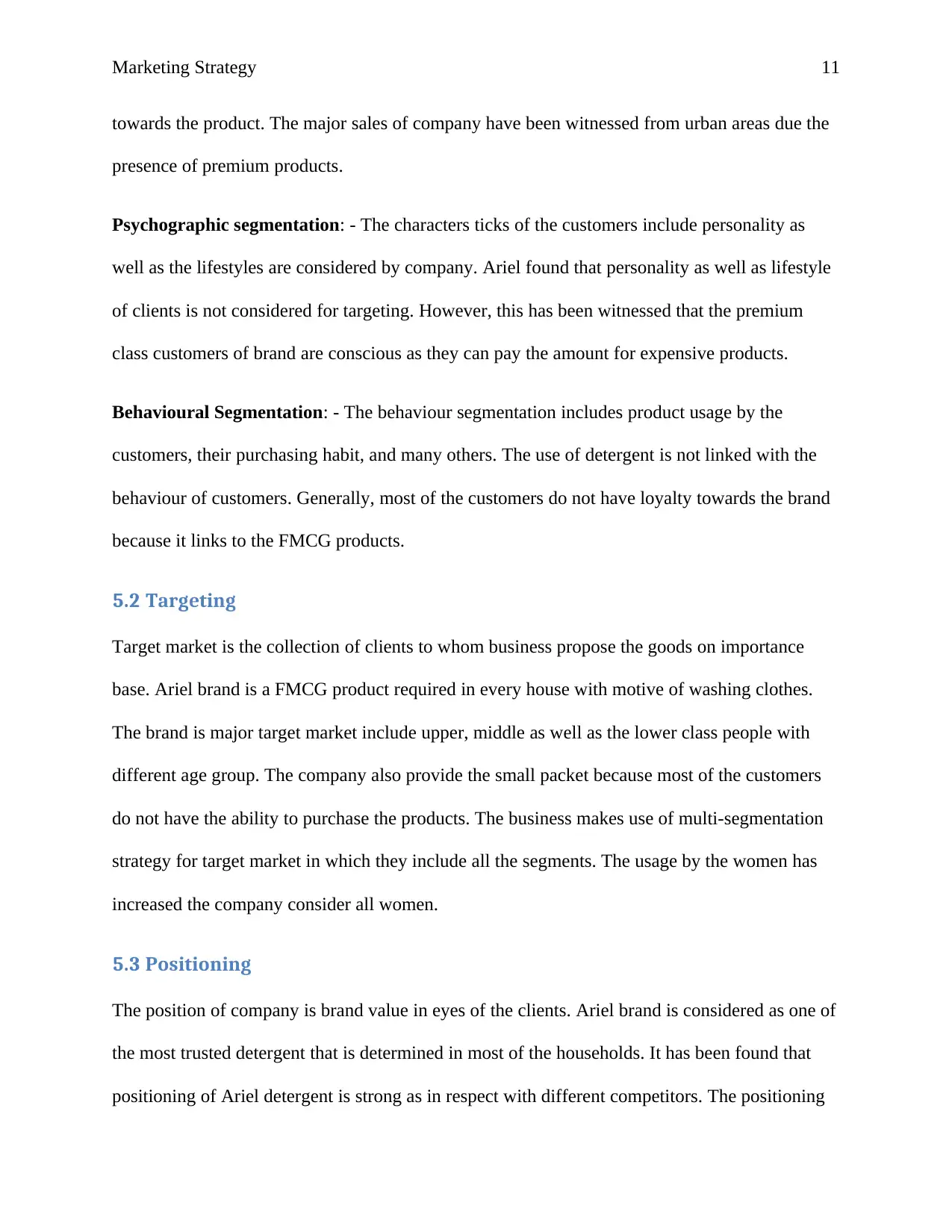
Marketing Strategy 11
towards the product. The major sales of company have been witnessed from urban areas due the
presence of premium products.
Psychographic segmentation: - The characters ticks of the customers include personality as
well as the lifestyles are considered by company. Ariel found that personality as well as lifestyle
of clients is not considered for targeting. However, this has been witnessed that the premium
class customers of brand are conscious as they can pay the amount for expensive products.
Behavioural Segmentation: - The behaviour segmentation includes product usage by the
customers, their purchasing habit, and many others. The use of detergent is not linked with the
behaviour of customers. Generally, most of the customers do not have loyalty towards the brand
because it links to the FMCG products.
5.2 Targeting
Target market is the collection of clients to whom business propose the goods on importance
base. Ariel brand is a FMCG product required in every house with motive of washing clothes.
The brand is major target market include upper, middle as well as the lower class people with
different age group. The company also provide the small packet because most of the customers
do not have the ability to purchase the products. The business makes use of multi-segmentation
strategy for target market in which they include all the segments. The usage by the women has
increased the company consider all women.
5.3 Positioning
The position of company is brand value in eyes of the clients. Ariel brand is considered as one of
the most trusted detergent that is determined in most of the households. It has been found that
positioning of Ariel detergent is strong as in respect with different competitors. The positioning
towards the product. The major sales of company have been witnessed from urban areas due the
presence of premium products.
Psychographic segmentation: - The characters ticks of the customers include personality as
well as the lifestyles are considered by company. Ariel found that personality as well as lifestyle
of clients is not considered for targeting. However, this has been witnessed that the premium
class customers of brand are conscious as they can pay the amount for expensive products.
Behavioural Segmentation: - The behaviour segmentation includes product usage by the
customers, their purchasing habit, and many others. The use of detergent is not linked with the
behaviour of customers. Generally, most of the customers do not have loyalty towards the brand
because it links to the FMCG products.
5.2 Targeting
Target market is the collection of clients to whom business propose the goods on importance
base. Ariel brand is a FMCG product required in every house with motive of washing clothes.
The brand is major target market include upper, middle as well as the lower class people with
different age group. The company also provide the small packet because most of the customers
do not have the ability to purchase the products. The business makes use of multi-segmentation
strategy for target market in which they include all the segments. The usage by the women has
increased the company consider all women.
5.3 Positioning
The position of company is brand value in eyes of the clients. Ariel brand is considered as one of
the most trusted detergent that is determined in most of the households. It has been found that
positioning of Ariel detergent is strong as in respect with different competitors. The positioning
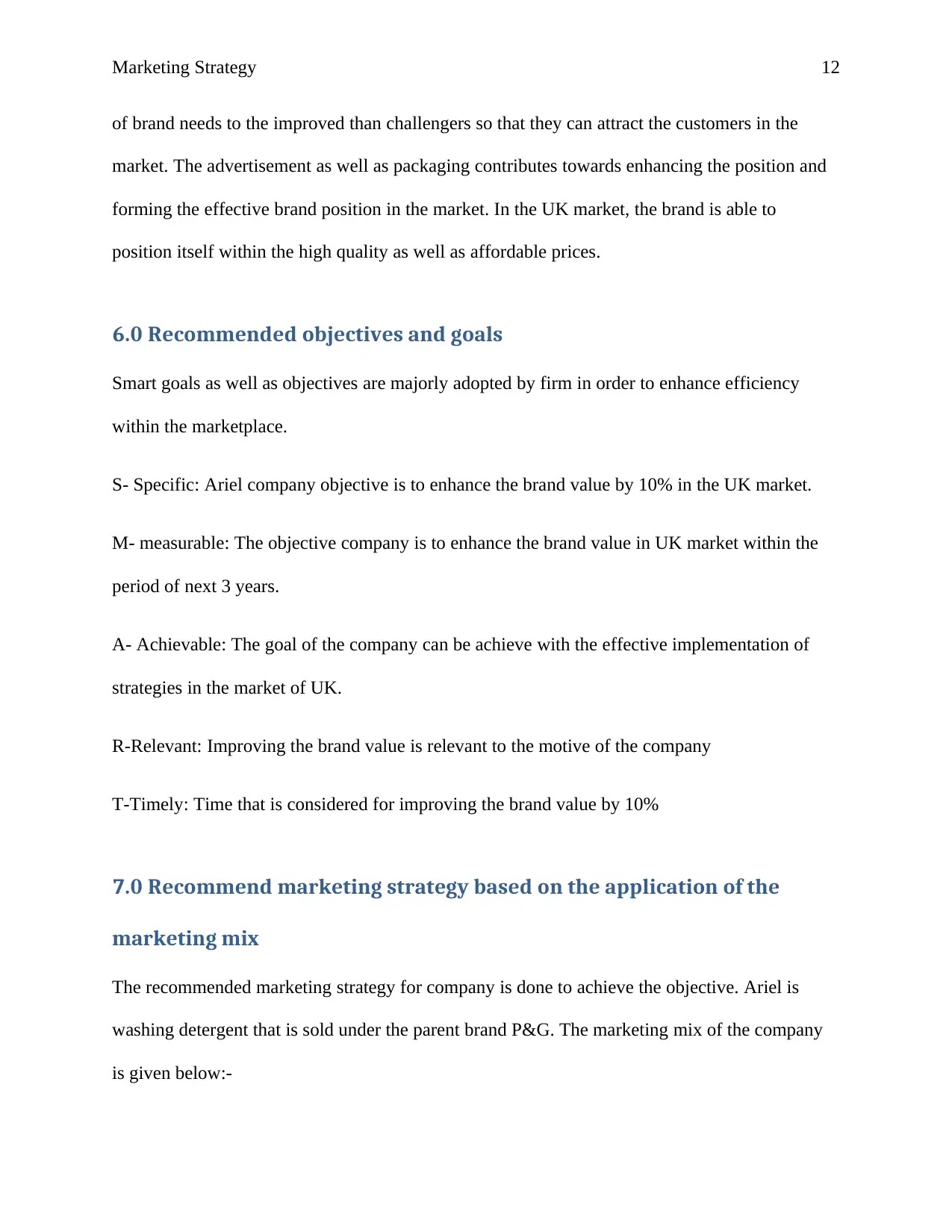
Marketing Strategy 12
of brand needs to the improved than challengers so that they can attract the customers in the
market. The advertisement as well as packaging contributes towards enhancing the position and
forming the effective brand position in the market. In the UK market, the brand is able to
position itself within the high quality as well as affordable prices.
6.0 Recommended objectives and goals
Smart goals as well as objectives are majorly adopted by firm in order to enhance efficiency
within the marketplace.
S- Specific: Ariel company objective is to enhance the brand value by 10% in the UK market.
M- measurable: The objective company is to enhance the brand value in UK market within the
period of next 3 years.
A- Achievable: The goal of the company can be achieve with the effective implementation of
strategies in the market of UK.
R-Relevant: Improving the brand value is relevant to the motive of the company
T-Timely: Time that is considered for improving the brand value by 10%
7.0 Recommend marketing strategy based on the application of the
marketing mix
The recommended marketing strategy for company is done to achieve the objective. Ariel is
washing detergent that is sold under the parent brand P&G. The marketing mix of the company
is given below:-
of brand needs to the improved than challengers so that they can attract the customers in the
market. The advertisement as well as packaging contributes towards enhancing the position and
forming the effective brand position in the market. In the UK market, the brand is able to
position itself within the high quality as well as affordable prices.
6.0 Recommended objectives and goals
Smart goals as well as objectives are majorly adopted by firm in order to enhance efficiency
within the marketplace.
S- Specific: Ariel company objective is to enhance the brand value by 10% in the UK market.
M- measurable: The objective company is to enhance the brand value in UK market within the
period of next 3 years.
A- Achievable: The goal of the company can be achieve with the effective implementation of
strategies in the market of UK.
R-Relevant: Improving the brand value is relevant to the motive of the company
T-Timely: Time that is considered for improving the brand value by 10%
7.0 Recommend marketing strategy based on the application of the
marketing mix
The recommended marketing strategy for company is done to achieve the objective. Ariel is
washing detergent that is sold under the parent brand P&G. The marketing mix of the company
is given below:-
Paraphrase This Document
Need a fresh take? Get an instant paraphrase of this document with our AI Paraphraser

Marketing Strategy 13
Product strategy: - Ariel Company is considered as the premium quality of the quality of
detergent that is most popular for eliminating the strains majorly from clothes. This product is
most appropriate for the effective usage of washing machine. It is recommended to Ariel brand
to do not have any bleaching component due to which they safeguard the colours of clothes
(Išoraitė, 2016). The brand should bring the innovation in product that is done by introducing
fragrance with the power bristles. In addition, the feature of Ariel includes the bar as well as gel
that gains the competitive advantage over alike sort of brand in marketplace.
Price strategy: - Price is considered as the amount paid by the brand for getting the product. The
brand uses the premium pricing strategy through which they can encounter requirements of high-
class clients in market. P&G has distinct team who works on pricing of products so they should
reduce the price and keep the competitive prices (Bhasin, 2016). This recommended strategy will
help the brand to attract maximum clients in market that will enhance brand value. For the rural
area, Ariel brand should introduce the low price goods that have extended within company that
will increase number of customers.
Place strategy: - Place is the location from where the customers purchase the products and the
company sells the product through different distributors. P&G introduced Ariel in the market of
UK through which they has extended it within the market. It is recommended to company to
expand the distribution network that remains strong as well as it supply product within market
(Khan, Khan and Khan, 2011). Ariel brand should enhance distribution and products to each
store in the retail store to adopt the distribution. The recommendation to place strategy has been
done through which they can meet their goals.
Product strategy: - Ariel Company is considered as the premium quality of the quality of
detergent that is most popular for eliminating the strains majorly from clothes. This product is
most appropriate for the effective usage of washing machine. It is recommended to Ariel brand
to do not have any bleaching component due to which they safeguard the colours of clothes
(Išoraitė, 2016). The brand should bring the innovation in product that is done by introducing
fragrance with the power bristles. In addition, the feature of Ariel includes the bar as well as gel
that gains the competitive advantage over alike sort of brand in marketplace.
Price strategy: - Price is considered as the amount paid by the brand for getting the product. The
brand uses the premium pricing strategy through which they can encounter requirements of high-
class clients in market. P&G has distinct team who works on pricing of products so they should
reduce the price and keep the competitive prices (Bhasin, 2016). This recommended strategy will
help the brand to attract maximum clients in market that will enhance brand value. For the rural
area, Ariel brand should introduce the low price goods that have extended within company that
will increase number of customers.
Place strategy: - Place is the location from where the customers purchase the products and the
company sells the product through different distributors. P&G introduced Ariel in the market of
UK through which they has extended it within the market. It is recommended to company to
expand the distribution network that remains strong as well as it supply product within market
(Khan, Khan and Khan, 2011). Ariel brand should enhance distribution and products to each
store in the retail store to adopt the distribution. The recommendation to place strategy has been
done through which they can meet their goals.
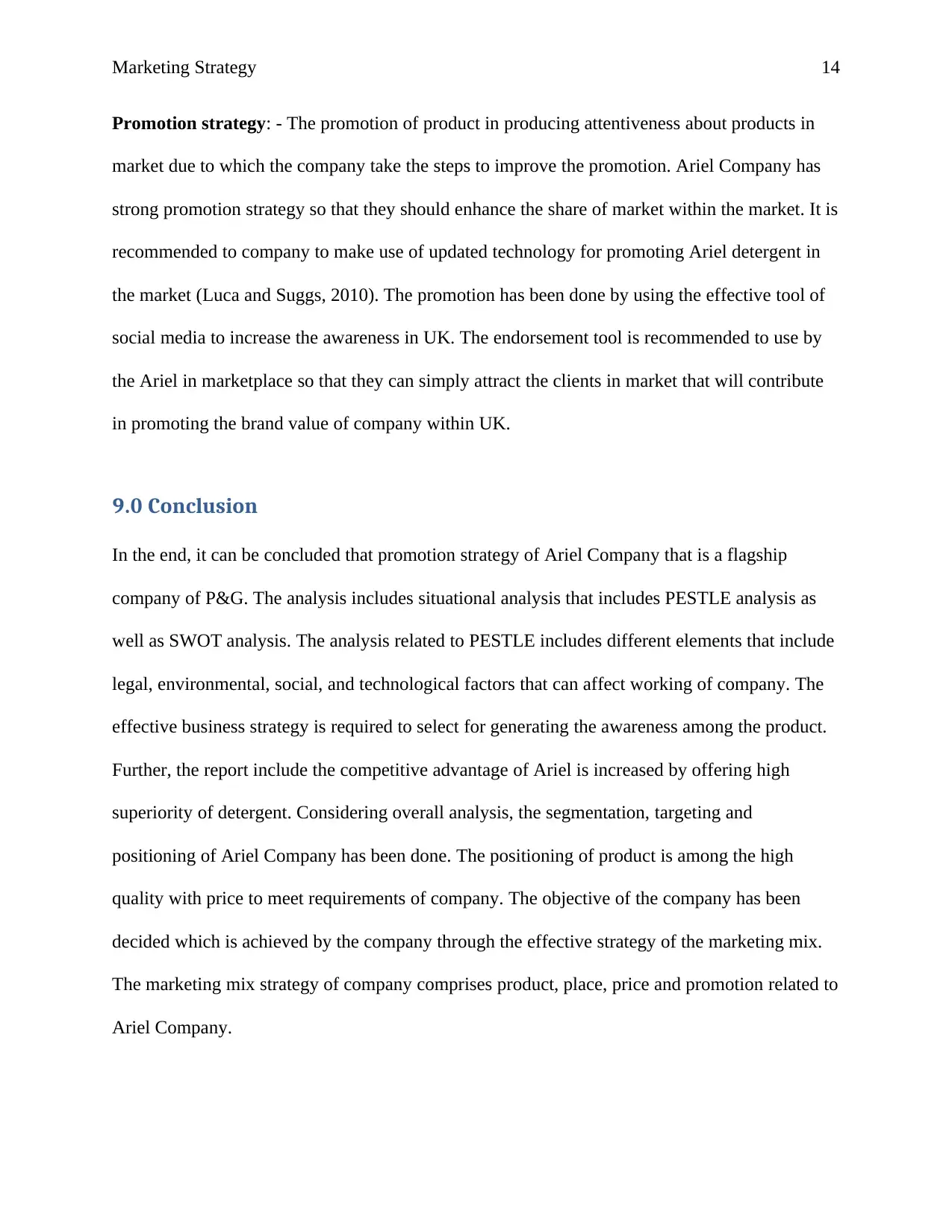
Marketing Strategy 14
Promotion strategy: - The promotion of product in producing attentiveness about products in
market due to which the company take the steps to improve the promotion. Ariel Company has
strong promotion strategy so that they should enhance the share of market within the market. It is
recommended to company to make use of updated technology for promoting Ariel detergent in
the market (Luca and Suggs, 2010). The promotion has been done by using the effective tool of
social media to increase the awareness in UK. The endorsement tool is recommended to use by
the Ariel in marketplace so that they can simply attract the clients in market that will contribute
in promoting the brand value of company within UK.
9.0 Conclusion
In the end, it can be concluded that promotion strategy of Ariel Company that is a flagship
company of P&G. The analysis includes situational analysis that includes PESTLE analysis as
well as SWOT analysis. The analysis related to PESTLE includes different elements that include
legal, environmental, social, and technological factors that can affect working of company. The
effective business strategy is required to select for generating the awareness among the product.
Further, the report include the competitive advantage of Ariel is increased by offering high
superiority of detergent. Considering overall analysis, the segmentation, targeting and
positioning of Ariel Company has been done. The positioning of product is among the high
quality with price to meet requirements of company. The objective of the company has been
decided which is achieved by the company through the effective strategy of the marketing mix.
The marketing mix strategy of company comprises product, place, price and promotion related to
Ariel Company.
Promotion strategy: - The promotion of product in producing attentiveness about products in
market due to which the company take the steps to improve the promotion. Ariel Company has
strong promotion strategy so that they should enhance the share of market within the market. It is
recommended to company to make use of updated technology for promoting Ariel detergent in
the market (Luca and Suggs, 2010). The promotion has been done by using the effective tool of
social media to increase the awareness in UK. The endorsement tool is recommended to use by
the Ariel in marketplace so that they can simply attract the clients in market that will contribute
in promoting the brand value of company within UK.
9.0 Conclusion
In the end, it can be concluded that promotion strategy of Ariel Company that is a flagship
company of P&G. The analysis includes situational analysis that includes PESTLE analysis as
well as SWOT analysis. The analysis related to PESTLE includes different elements that include
legal, environmental, social, and technological factors that can affect working of company. The
effective business strategy is required to select for generating the awareness among the product.
Further, the report include the competitive advantage of Ariel is increased by offering high
superiority of detergent. Considering overall analysis, the segmentation, targeting and
positioning of Ariel Company has been done. The positioning of product is among the high
quality with price to meet requirements of company. The objective of the company has been
decided which is achieved by the company through the effective strategy of the marketing mix.
The marketing mix strategy of company comprises product, place, price and promotion related to
Ariel Company.

Marketing Strategy 15
10.0 References
Ariel (2019) About us [Online]. Available from: https://www.ariel.co.uk/en-gb/about-ariel/about-
us
Ariel (2019) Ariel Home [Online]. Available from: https://www.ariel.co.uk/en-gb [Accessed on
26th June 2019]
Armstrong, G., Adam, S., Denize, S. and Kotler, P. (2014) Principles of marketing. 6th edition.
Welbourne: Pearson Australia.
Baker, M. J. (2014) Marketing strategy and management. London: Palgrave Macmillan.
Bhasin, H. (2016) Marketing mix of Ariel [Online]. Available from:
http://www.marketing91.com/marketing-mix-of-ariel/ [Accessed on 26th June 2019]
Bhasin, H. (2016) SWOT Analysis of Ariel [Online]. Available from:
https://www.marketing91.com/swot-analysis-ariel/ [Accessed on 26th June 2019]
Chernev, A. (2018) Strategic marketing management. Chicago:Cerebellum Press.
David, F.R. (2011) Strategic management: Concepts and cases. India: Pearson/Prentice Hall.
Dawson, J.A. (2014) The Marketing Environment (RLE Marketing). New York: Routledge.
Frynas, J.G. and Mellahi, K. (2015) Global strategic management. USA: Oxford University
Press.
Grant, R.M. (2016) Contemporary strategy analysis: Text and cases edition. New Jersey: John
Wiley & Sons.
10.0 References
Ariel (2019) About us [Online]. Available from: https://www.ariel.co.uk/en-gb/about-ariel/about-
us
Ariel (2019) Ariel Home [Online]. Available from: https://www.ariel.co.uk/en-gb [Accessed on
26th June 2019]
Armstrong, G., Adam, S., Denize, S. and Kotler, P. (2014) Principles of marketing. 6th edition.
Welbourne: Pearson Australia.
Baker, M. J. (2014) Marketing strategy and management. London: Palgrave Macmillan.
Bhasin, H. (2016) Marketing mix of Ariel [Online]. Available from:
http://www.marketing91.com/marketing-mix-of-ariel/ [Accessed on 26th June 2019]
Bhasin, H. (2016) SWOT Analysis of Ariel [Online]. Available from:
https://www.marketing91.com/swot-analysis-ariel/ [Accessed on 26th June 2019]
Chernev, A. (2018) Strategic marketing management. Chicago:Cerebellum Press.
David, F.R. (2011) Strategic management: Concepts and cases. India: Pearson/Prentice Hall.
Dawson, J.A. (2014) The Marketing Environment (RLE Marketing). New York: Routledge.
Frynas, J.G. and Mellahi, K. (2015) Global strategic management. USA: Oxford University
Press.
Grant, R.M. (2016) Contemporary strategy analysis: Text and cases edition. New Jersey: John
Wiley & Sons.
Secure Best Marks with AI Grader
Need help grading? Try our AI Grader for instant feedback on your assignments.
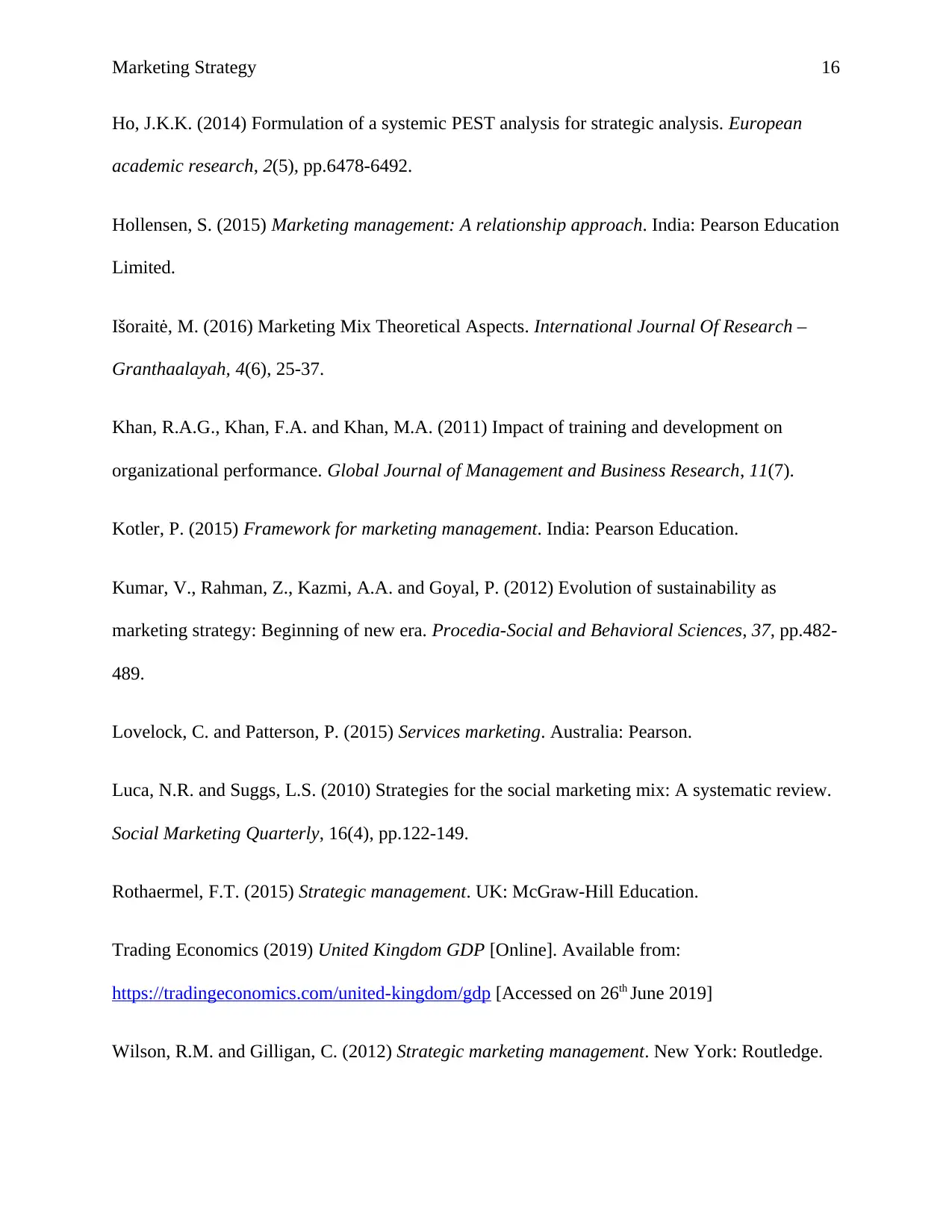
Marketing Strategy 16
Ho, J.K.K. (2014) Formulation of a systemic PEST analysis for strategic analysis. European
academic research, 2(5), pp.6478-6492.
Hollensen, S. (2015) Marketing management: A relationship approach. India: Pearson Education
Limited.
Išoraitė, M. (2016) Marketing Mix Theoretical Aspects. International Journal Of Research –
Granthaalayah, 4(6), 25-37.
Khan, R.A.G., Khan, F.A. and Khan, M.A. (2011) Impact of training and development on
organizational performance. Global Journal of Management and Business Research, 11(7).
Kotler, P. (2015) Framework for marketing management. India: Pearson Education.
Kumar, V., Rahman, Z., Kazmi, A.A. and Goyal, P. (2012) Evolution of sustainability as
marketing strategy: Beginning of new era. Procedia-Social and Behavioral Sciences, 37, pp.482-
489.
Lovelock, C. and Patterson, P. (2015) Services marketing. Australia: Pearson.
Luca, N.R. and Suggs, L.S. (2010) Strategies for the social marketing mix: A systematic review.
Social Marketing Quarterly, 16(4), pp.122-149.
Rothaermel, F.T. (2015) Strategic management. UK: McGraw-Hill Education.
Trading Economics (2019) United Kingdom GDP [Online]. Available from:
https://tradingeconomics.com/united-kingdom/gdp [Accessed on 26th June 2019]
Wilson, R.M. and Gilligan, C. (2012) Strategic marketing management. New York: Routledge.
Ho, J.K.K. (2014) Formulation of a systemic PEST analysis for strategic analysis. European
academic research, 2(5), pp.6478-6492.
Hollensen, S. (2015) Marketing management: A relationship approach. India: Pearson Education
Limited.
Išoraitė, M. (2016) Marketing Mix Theoretical Aspects. International Journal Of Research –
Granthaalayah, 4(6), 25-37.
Khan, R.A.G., Khan, F.A. and Khan, M.A. (2011) Impact of training and development on
organizational performance. Global Journal of Management and Business Research, 11(7).
Kotler, P. (2015) Framework for marketing management. India: Pearson Education.
Kumar, V., Rahman, Z., Kazmi, A.A. and Goyal, P. (2012) Evolution of sustainability as
marketing strategy: Beginning of new era. Procedia-Social and Behavioral Sciences, 37, pp.482-
489.
Lovelock, C. and Patterson, P. (2015) Services marketing. Australia: Pearson.
Luca, N.R. and Suggs, L.S. (2010) Strategies for the social marketing mix: A systematic review.
Social Marketing Quarterly, 16(4), pp.122-149.
Rothaermel, F.T. (2015) Strategic management. UK: McGraw-Hill Education.
Trading Economics (2019) United Kingdom GDP [Online]. Available from:
https://tradingeconomics.com/united-kingdom/gdp [Accessed on 26th June 2019]
Wilson, R.M. and Gilligan, C. (2012) Strategic marketing management. New York: Routledge.

Marketing Strategy 17
1 out of 18
Related Documents
Your All-in-One AI-Powered Toolkit for Academic Success.
+13062052269
info@desklib.com
Available 24*7 on WhatsApp / Email
![[object Object]](/_next/static/media/star-bottom.7253800d.svg)
Unlock your academic potential
© 2024 | Zucol Services PVT LTD | All rights reserved.





